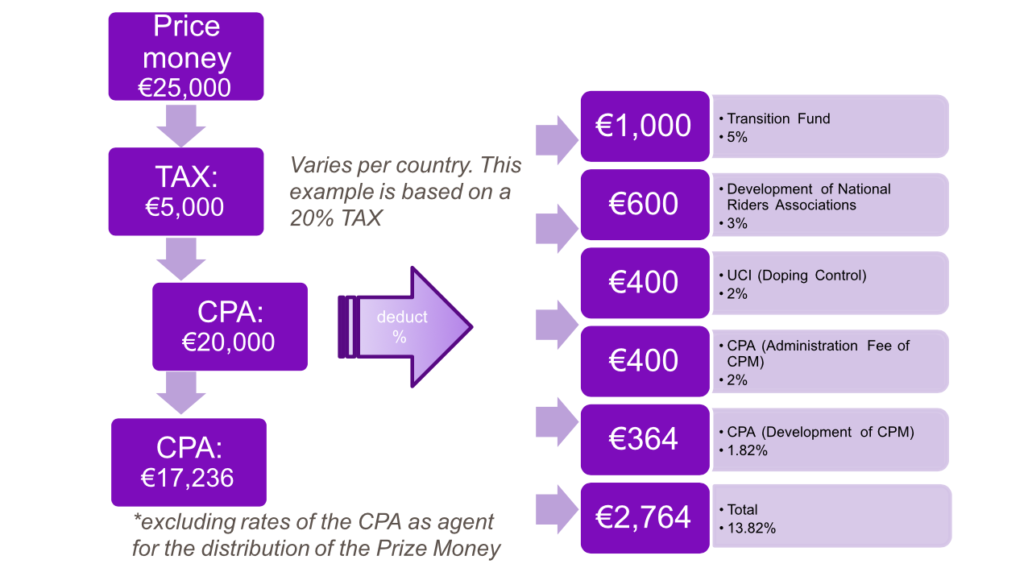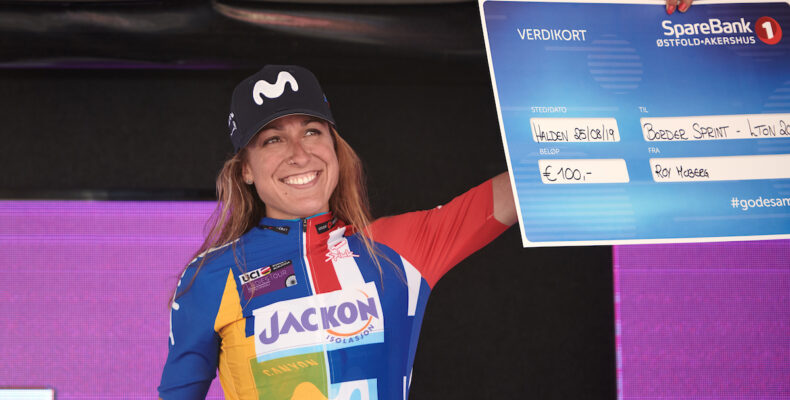The UCI launched the Centralised Prizemoney Management system (“CPM”)in January 2019 for Men’s Professional Cycling, covering the distribution of prizes from the WT, HC races, the Pro Series and Class 1.
As of 1st January 2022, this system will be in place for women's professional cycling as well. What does this mean for you as a rider? Read on to find out.
Whilst the UCI has indicated to the TCA Rider Council representatives that the Women’s centralised prizemoney management system will not be identical the Men’s CPM , the TCA is of the view that an understanding of how the Men’s CPM works is essential, as the Women’s CPM system may evolve to have similarities with, or to mirror, it in the future. It is also important to be aware of problems with the Men’s CPM, in order that mistakes or inefficiencies are not replicated in the Women’s CPM.
How does the men's centralised prizemoney management system work?
The CPM comprises two layers, as detailed below.
Layer 1:
The picture uses Prudential RideLondon Classique WWT as an example of how it would work, if the Men’s CPM system is applied.
Several deductions (as explained in the diagram) are taken from the gross amount of prize money.

The total winning amount paid by the race organization EUR 25,000 gross (EUR 20,000 net of tax). The net amount goes to the CPA, that manages the CPM. As demonstrated, multiple deductions, comprising a total of 13,82%, are taken from this net amount, leaving EUR 17,236 available.
Further details of the deductions:
- Career and Transition Fund
- 5% is deducted for a ‘Transition Fund’.
- Riders that retire from professional cycling are entitled to seek amount of money from the Transition Fund, to assist them with their career after cycling.
- The Transition Fund is controversial, as retired male riders were left stranded when CPA failed to meet pay outs. Furthermore, the Transition Fund currently runs at a deficit, of which latest figures from the CPA put this at approximately -EUR 2.8 million. Therefore, use of this Transition Fund should not be introduced into Women’s Cycling. The TCA are not aware of a viable plan by the CPA or the UCI to restore this deficit.
- In addition, given the relatively low amounts of prize money available in women’s cycling, it is also questionable if a Transition Fund for women can provide any amounts which are sufficient to be considered meaningful for post career assistance.
- Development of National Riders Associations
- 3% is deducted for the National Riders Associations in countries where races have taken place (for example, the 3% deduction of all French races go to the French Riders Associations UNCP).
- It is not clear where the deducted amount of money goes, when a country does not have a national riders association and/or this association is not a member of the CPA. This should be clarified by the CPA and/or UCI.
- Anti Doping
- 2% is deducted for anti-doping program.
- This amount is additional to the amount allocated to anti-doping (for the biological passport) that is paid by teams as part of their team registration fee.
- Women’s World Teams for example contribute EUR 10,000 and the Women’s Continental Teams contribute EUR 2,250 for anti doping per year, as part of their team registration fee.
- Organisers also contribute to anti-doping costs, with their contribution depending on the category and the days that are raced.
- 3,82% CPA fee
- 2% is deducted for CPA administration costs, and a further 1,82% is deducted for Development of the CPM Platform.
- UCI has not provided any insight into the rationale behind these percentages. This is a concern, given that additional administration costs are also paid to the CPA in the second layer. These costs are of course paid to the CPA in addition to the financial contribution already made to the CPA by the UCI.
Layer 2:
After the percentages have been deducted in Layer 1 from the winner’s total prize money (EUR 25.000. gross (EUR 20.000 net), payment of the prize money will take place.
The CPA charges the following administration costs for this[1] (this is additional to the 3.82% mentioned above in Layer 1):
- Direct payment to the riders: EUR 2,500 fee per season
- Payout via the team's account number costs EUR 1,000 fee per season
- Payout to a third-party costs EUR 600 per season
It is not possible to opt for a independent third party, even if this independent third party is cheaper and even if you are not a member of CPA.
[1] Based on current Men’s system.
The CPM system for Women’s Professional Cycling - with effect from 1st January 2022
The TCA’s understanding from the UCI is that for 2022, only the 1,82 % will be deducted* from the prize money (for the development of the CPM).
*NOTE: UCI mentioned this in their communication towards the TCA Riders Council members, but did not respond when asked for formal confirmation.
C1 and C2 races are not part of the Women’s CPM system. Those races are often the hardest to collect and receiving the prize money for the riders. Therefore, we ask the UCI to discuss incorporating these race categories in a future version of the Women’s CPM.
We furthermore want to have clarified how this system ensures that organisers pay the prize money within a reasonable time and thus addresses the problem of late/slow/never received payments by the riders.
The Professional Cycling Council (PCC) will decide next year on how the system will be evolved in Women’s Cycling.
We have asked the UCI to listen to the riders voice in this discussion too, as the TCA were not consulted with the initial plans (neither on the first layer and the several deductions that are made, or the second layer fees and payment). We at the TCA recommend that teams and riders could opt for distribution by an independent third party, and having more options than just CPM. This prevents a monopoly, and is more likely to makes fees transparent, and possibly lower.
The prize money belongs to the riders, they should be entitled to take part in this discussion.
After questions from the TCA Rider Council representatives the UCI have given an insight in the CPM system and explained the basics. As still a lot of questions were unanswered the TCA has requested communication and clarity from the UCI, via a [letter from the Rider Council]. The letter asked some key questions. Neither the TCA nor the Rider Council have received a response to these questions. The TCA and the Rider Council will continue to ask the UCI respond to our questions and to involve the Rider Council in discussions on the prize money administration. For now, please see above for the information the TCA is aware of, in order to keep you all informed of the changes, the impact on you as riders and your prize money, and of the questions we think should be raised.
Main questions on the suggested prizemoney system (asked to UCI 28-9-2021 / 17-11-2021)
- Which races will be covered by the CPM system?
- What to do with the races not covered by the system, and notoriously the hardest to collect prize money from?
- Are the UCI and CPA not creating a monopoly towards other companies who distribute prizemoney (at a lower rate)?
- Is the independency of CPA, as a union, guaranteed?
- If riders don’t want to have their prizemoney managed by CPA, is there an alternative available?
- How can you justify that riders that are not a member of CPA do have to contribute to that union and manages money on their behalf?
- The prizewinning riders contribute the most to the whole system. Is that fair, looking at each remittance/percentage that is taken of the prize money?
- How do percentages to be paid relate to the costs actually incurred
- How does the remittance for the transition funds work -who contributes, who benefits, could the prize money fund a reasonable amount for this fund?
- How does CPM ensure that organizers pay out the prize money on time


This is a lot of randomly selected overhead charges – sounds more like a UCI/CPA tax. Seems neither fair nor transparent. Would be ridiculous with the low amount of prize money in women’s cycling. Prize money belongs to the riders who earned it!